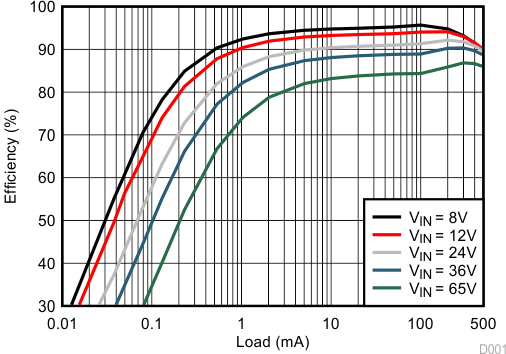SNVSA67B December 2016 – June 2017 LM5166
PRODUCTION DATA.
- 1 Features
- 2 Applications
- 3 Description
- 4 Revision History
- 5 Pin Configuration and Functions
- 6 Specifications
-
7 Detailed Description
- 7.1 Overview
- 7.2 Functional Block Diagram
- 7.3
Feature Description
- 7.3.1 Integrated Power MOSFETs
- 7.3.2 Selectable PFM or COT Mode Converter Operation
- 7.3.3 Low Dropout Operation and 100% Duty Cycle Mode
- 7.3.4 Adjustable Output Voltage (FB)
- 7.3.5 Adjustable Current Limit
- 7.3.6 Precision Enable (EN) and Hysteresis (HYS)
- 7.3.7 Power Good (PGOOD)
- 7.3.8 Configurable Soft Start (SS)
- 7.3.9 Short-Circuit Operation
- 7.3.10 Thermal Shutdown
- 7.4 Device Functional Modes
-
8 Applications and Implementation
- 8.1 Application Information
- 8.2
Typical Applications
- 8.2.1
Design 1: Wide VIN, Low IQ, High-Efficiency COT Converter Rated at 5 V, 500 mA
- 8.2.1.1 Design Requirements
- 8.2.1.2
Detailed Design Procedure
- 8.2.1.2.1 Custom Design With WEBENCH® Tools
- 8.2.1.2.2 Feedback Resistors - RFB1, RFB2
- 8.2.1.2.3 Switching Frequency - RT
- 8.2.1.2.4 Filter Inductance - LF
- 8.2.1.2.5 Output Capacitors - COUT
- 8.2.1.2.6 Ripple Generation Network - RESR, CFF
- 8.2.1.2.7 Input Capacitor - CIN
- 8.2.1.2.8 Soft-Start Capacitor - CSS
- 8.2.1.2.9 Application Curves
- 8.2.2 Design 2: Wide VIN, Low IQ COT Converter Rated at 3.3 V, 500 mA
- 8.2.3 Design 3: High-Density PFM Converter Rated at 3.3 V, 0.3 A
- 8.2.4 Design 4: Wide VIN, Low IQ PFM Converter Rated at 5 V, 500 mA
- 8.2.5
Design 5: 12-V, 300-mA COT Converter Operating From 24-V or 48-V Input
- 8.2.5.1 Design Requirements
- 8.2.5.2
Detailed Design Procedure
- 8.2.5.2.1 Peak Current Limit Setting - RILIM
- 8.2.5.2.2 Switching Frequency - RRT
- 8.2.5.2.3 Inductor - LF
- 8.2.5.2.4 Input and Output Capacitors - CIN, COUT
- 8.2.5.2.5 Feedback Resistors - RFB1, RFB2
- 8.2.5.2.6 Ripple Generation Network - RA, CA, CB
- 8.2.5.2.7 Undervoltage Lockout Setpoint - RUV1, RUV2, RHYS
- 8.2.5.2.8 Soft Start - CSS
- 8.2.5.3 Application Curves
- 8.2.1
Design 1: Wide VIN, Low IQ, High-Efficiency COT Converter Rated at 5 V, 500 mA
- 9 Power Supply Recommendations
- 10Layout
- 11Device and Documentation Support
- 12Mechanical, Packaging, and Orderable Information
Package Options
Mechanical Data (Package|Pins)
- DRC|10
Thermal pad, mechanical data (Package|Pins)
- DRC|10
Orderable Information
1 Features
- Wide Input Voltage Range of 3 V to 65 V
- 9.7-µA No-Load Quiescent Current
- –40°C to 150°C Junction Temperature Range
- Fixed (3.3-V, 5-V) or Adjustable VOUT Options
- Meets EN55022 / CISPR 22 EMI Standards
- Integrated 1-Ω PFET Buck Switch
- Supports 100% Duty Cycle for Low Dropout
- Integrated 0.5-Ω NFET Synchronous Rectifier
- Eliminates External Schottky Diode
- Programmable Peak Current Limit Supports:
- 500-mA, 300-mA, or 200-mA Loads
- Selectable PFM or COT Mode Operation
- 1.223-V ±1.2% Internal Voltage Reference
- Switching Frequency up to 600 kHz
- 900-µs Internal or Externally-Adjustable Soft Start
- Diode Emulation and Pulse Skipping for Ultra-High Light-Load Efficiency
- No Loop Compensation or Bootstrap Components
- Precision Enable and Input UVLO With Hysteresis
- Open-Drain Power Good Indicator
- Thermal Shutdown Protection With Hysteresis
- Pin-to-Pin Compatible With the LM5165
- 10-Pin, 3-mm × 3-mm VSON Package
- Create a Custom Regulator Design Using WEBENCH® Power Designer
2 Applications
- Factory and Building Automation
- Automotive and Battery-Powered Applications
- High Voltage LDO Replacement
- Low Power Bias Supplies
3 Description
The LM5166 is a compact, easy-to-use, 3-V to 65-V, ultra-low IQ synchronous buck converter with high efficiency over wide input voltage and load current ranges. With integrated high-side and low-side power MOSFETs, up to 500 mA of output current can be delivered at fixed output voltages of 3.3 V or 5 V, or an adjustable output. The converter is designed to simplify implementation while providing options to optimize the performance for the target application. Pulse frequency modulation (PFM) mode is selected for optimal light-load efficiency or constant on-time (COT) control for nearly constant operating frequency. Both control schemes do not require loop compensation while providing excellent line and load transient response and short PWM on-time for large step-down conversion ratios.
The high-side P-channel MOSFET can operate at 100% duty cycle for lowest dropout voltage and does not require a bootstrap capacitor for gate drive. Also, the current limit setpoint is adjustable to optimize inductor selection for a particular load current requirement. Selectable and adjustable start-up timing options include minimum delay (no soft start), internally fixed (900 μs), and externally programmable soft start using a capacitor. An open-drain PGOOD indicator can be used for sequencing, fault reporting, and output voltage monitoring. The LM5166 is available in a 10-pin VSON package with 0.5-mm pin pitch.
Device Information(1)
| PART NUMBER | OUTPUT | PACKAGE |
|---|---|---|
| LM5166 | Adjustable | VSON (10) |
| LM5166X | 5-V fixed | |
| LM5166Y | 3.3-V fixed |
- For all available packages, see the orderable addendum at the end of the data sheet.

